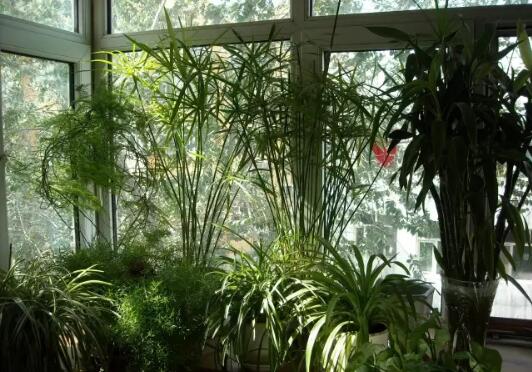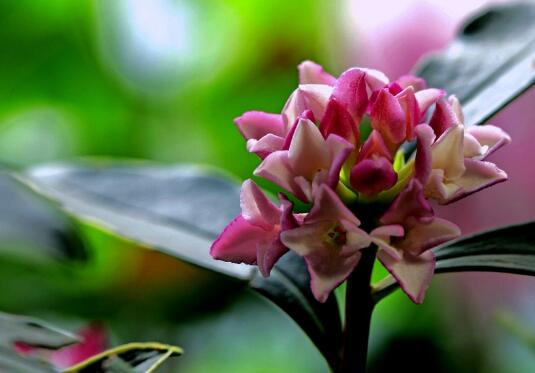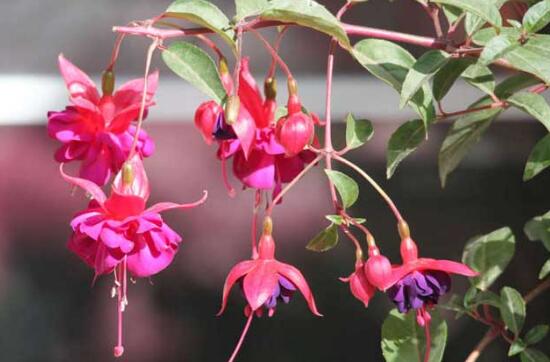What about the yellowing of the leaves of Phyllostachys pubescens? the causes and solutions of the yellowing and drying of the leaves of Phyllostachys pubescens
Phyllostachys pubescens is a common plant in people's life, it has a good ornamental, and it can not only be potted, but also can be planted in a large area. However, the ornamental plants will also affect their overall aesthetic sense if their leaves turn yellow. What if the leaves of Phyllostachys pubescens turn yellow? How to solve the yellow hair and dry hair of Polygonatum odoratum leaves? Next, the editor will take you to learn about it.
What if the leaves of Phyllostachys pubescens turn yellow? find the reason.

If we want to know how to do the yellowing of the leaves of Phyllostachys pubescens, first of all, we have to find the cause and know what is the cause in order to deal with it. Such as too strong light, improper fertilization and watering are the causes of this phenomenon, as for the specific solutions are described below, let's take a look.
Second, the causes of the yellowing and drying of the leaves of Phyllostachys pubescens, with solutions.
1. Improper fertilization should be diluted before application.
Fertilizer is one of the main nutrients in the growth process of Phyllostachys pubescens. If we apply too little fertilizer or the concentration of fertilizer is too high, it will cause the leaves of water bamboo to turn yellow. If it is fertilized too little, it will turn yellow due to lack of nutrients, and if the fertilizer concentration is too high, it will burn the plant and cause yellowing.
Solution: Phyllostachys pubescens has a high demand for fertilizer in the growth process, and its growth will be significantly better only after using fertilizer. Spring and summer are the peak growing seasons, so we should apply fertilizer frequently, but the fertilizer concentration should not be too high, and we must dilute it with water before applying it. If the concentration is too high, it is easy to burn the plant.
two。 Watering too little, keep the soil moist / avoid stagnant water
Phyllostachys pubescens prefers a warm and humid environment. When we breed it, especially after it enters the growing period, its demand for water is very high. If we always forget to water the plant, the lack of water will lead to the yellowing of its leaves.
Solution: if it is caused by too little watering, we do not have to pour water immediately, but step by step. If we irrigate too much at one time, it is easy to cause the plant to rot. Generally speaking, when the weather is relatively dry, it can be watered once every 3-5 days.
3. The light is too strong, pay attention to shade in summer
Phyllostachys pubescens is a kind of light-loving plant, if the light is more suitable in spring and autumn, we can keep it outdoors and let it receive light all day, but it is more afraid of strong light, so it still needs shade after entering summer. otherwise, if the light is too strong, it is easy to burn the plant and yellowing leaves.
Solution: if the leaves of Phyllostachys pubescens turn yellow because of the strong light, we should keep it indoors in half-shade in time, so that the leaves of a section of plants will slowly turn green.
4. Infestation of diseases and insect pests, timely treatment
In the process of culturing Phyllostachys pubescens, if it is not cultured properly, it is easy to have diseases and insect pests and other problems. This kind of problems do great harm to the plants, which will not only lead to the yellowing of the leaves, but also cause the plants to wither and die.
Solution: if this problem is caused by diseases and insect pests, we must deal with it in time, because the longer the time drags on, the greater the harm to the plant. The specific treatment methods are introduced in the article "Prevention and Control of Diseases and insect pests of Phyllostachys pubescens". You can learn about it.
5. The environment does not adapt to the normal phenomenon
If our Phyllostachys pubescens is bought outside, then it is easy to have the problem of yellowing of leaves when it is bought back, which is a normal phenomenon, because this is a manifestation of inadaptability to the environment and requires an adaptation process. Generally normal maintenance slowly it will return to green.
Analysis on the causes of yellowing of Phyllostachys pubescens leaves
Phyllostachys pubescens, also known as Umbrella grass, windmill grass, etc., is a perennial herb of Cyperaceae. It is suitable for raising and watching potted plants or illustrating and cutting leaves at home. However, in the process of raising parasol grass, friends will find that the leaves will turn yellow and the leaf tips will turn yellow, so what about the yellowing leaves of Phyllostachys pubescens?
What if the leaves of Phyllostachys pubescens turn yellow? first, the basin soil is too dry.
The parasol grass likes to be wet and is afraid of drying. In the growth period should be timely watering, do not lose water. The lack of water will cause the leaves to curl, the leaf ends to be scorched yellow, and the plants to be dark, thus affecting the growth and ornamental.
What if the leaves of Phyllostachys pubescens turn yellow? second, the light is too strong.
The parasol grass likes to be half-overcast, and the strong sunlight can easily cause the leaf tip to scorch. It should be placed in a semi-overcast place from May to September.
What to do if the leaves of Phyllostachys pubescens turn yellow? 3. The air is too dry
Umbellifera prefers higher air humidity. When the air humidity is too low, the leaf ends often turn yellow and scorched, especially when it is hot in summer, water should often be sprayed to the branches and leaves of the plant and its surrounding environment to improve the humidity.
What about the yellowing leaves of Phyllostachys pubescens? 4. Low temperature
The parasol grass is not resistant to cold and stops growing below 12 ℃. It should be moved indoors for more than 5 ℃ in winter, otherwise it is easy to freeze and scorch the leaves.
Culture method of Phyllostachys pubescens (Upland parasite)
Culture methods of Upland Grass
Basic information of Upland Grass:
Scientific name: Cyperus altemifolius alias: umbrella grass, umbrella bamboo, water palm bamboo, water bamboo, windmill grass, eight mountain people.
Families and genera: Cyperaceae, Cyperus.
Perennial evergreen herbs, up to 1 m high. The roots are dense and slender, dark brown. Stems tufted, trigonous, unbranched. The leaves degenerated into a sheath, wrapped around the base of the stem. Involucral bracts leaflike, ca. 20, long and narrow, strip lanceolate, aggregated at the top of the stem like an umbrella, with obvious parallel veins. July flowering, compound umbels born in leaf axils, spikelets flattened, integrated capitate; flowers yellowish green or lavender. Achene triangle.
The parasol grass is green all the year round, elegant and straight, with slender and strange bracts growing on the top of a branch and stem, like open umbrellas; and like a small coconut tree whirling, interesting and unrestrained, with a southern charm, giving people a fresh and refreshing feeling. If you can use porcelain pots and rocks for hydroponic bonsai cultivation, then the charm is better.
[cultivated varieties of Upland parasol]
(1) cv. Gracilis: also known as dwarf bamboo. The plant type is relatively small, about 30 cm high.
(2) cv. Variegatus: also known as Chimonanthus roxburghii, Phyllostachys pubescens. Leaf blade with white longitudinal stripes.
[Upland parasol propagation] ramet, sowing, cutting.
1) ramet: combined with turning the basin in spring. The large dense plants in the full pot were divided into several clusters, each with a part of the stem and root system, cut off the misentangled old roots, and then planted separately.
(2) sowing: from April to May. The suitable temperature for germination is 12-18 degrees Celsius, and seedlings emerge about 10 days after sowing. When the seedling height is 5cm to 10cm, it can be planted in pot. Because the seed is very small, it is not easy to receive the seed.
(3) Cuttage: from April to June. Cut off the stem, keep the top 3 cm left and right, cut off the lower end; and leave 2-3 cm of bracts at the top of the stem to cut off the above parts, and then insert into the moist matrix, the depth of the insertion is based on the base of part of the piece. After insertion, under the condition of keeping the substrate moist and the temperature 20: 251C, it could take root after one month, and the seedlings could grow from the bract base.
[key points for planting and cultivation of Upland parasol grass]
(1) temperature: like warmth, the most suitable temperature for growth is 20-25 degrees Celsius. It is not hardy, grows slowly when it is below 16 degrees Celsius, and enters dormancy when it is below 12 degrees Celsius. The lowest temperature for overwintering is 5 degrees Celsius. When the temperature is lower than 5 °C, the stems and leaves are easy to yellowing and even the aboveground parts die. If the aboveground part is withered and dead, all the dead stems and leaves can be cut off, placed indoors in the sunny place, and keep the basin soil semi-wet, which will sprout and grow again in spring and quickly form an ideal plant shape.
(2) Illumination: like light. But avoid strong direct sunlight, excessive light will cause leaf tip scorch. From May to September, shade should be provided to cover 50% of the sun. It is resistant to semi-overcast and can grow well under the condition of sufficient scattered light. The rest of the time needs plenty of sunshine.
(3) watering: avoid drought and like wet water. Do not lose water in the growing season, the lack of water will make the leaves curl, even the apex withered and yellow, the plant dark and dull, thus affecting the growth and ornamental. Watering should "rather be wet than dry", provide sufficient water, and keep the basin soil moist rather than dry. Or it can be planted in a pot with no drainage hole at the bottom of the basin, so that it is not easy to lose water after dripping, so that the basin soil can be kept moist, and even if there is stagnant water, it will not affect the growth of the plant.
Can be cultivated by water culture, that is, after the plant is removed from the basin, wash the soil from the roots, cut off the old roots and aging stems, and place them in a transparent vase or other water-holding utensils, or in an impervious daffodil basin or porcelain plate. Cover the roots with coarse river sand, white pebbles, rain pebbles or pebbles to make the plants stand upright. At ordinary times, as long as you add water to maintain a certain water level when the moisture is reduced. Water is easy to deteriorate at high temperature in summer, so you should pay attention to change water.
(4) Environmental humidity: like humid environment, the air is too dry will also cause leaf tip scorch. During the growth period, especially when the weather is fine and the air is dry, water should often be sprayed to the branches, leaves and perimeter to increase the relative humidity of the air.
(5) fertilization: due to the rapid growth, fertilizer was applied once or twice a month during the growth period. Nitrogen fertilizer is mainly applied, but it is not suitable to apply too much, otherwise the stem grows too long and the plant grows too high, resulting in a proportion imbalance, which is not conducive to ornamental. When the plant growth is too prosperous, the application of nitrogen fertilizer should be suspended, and nitrogen fertilizer should be replenished only when the leaf color is yellow and the plant growth is weak. After autumn, stop applying nitrogen fertilizer and topdressing phosphorus and potassium fertilizer twice in order to make the plant safe and safe to survive the winter.
(6) pruning: strong sprouting power. During the growth period, the plant will continue to grow buds like bamboo shoots at the roots and show new leaves. When the plant is too dense, the old stem with yellowed stems and leaves can be thinned to facilitate ventilation and light transmission within the plant. If the stem can be trimmed according to the height, density and posture of the stem, and maintain its uneven and supine posture, it can better show the charm and elegance of the plant.
(7) turning the pot: after 1 or 2 years of pot planting, the pot soil will be hardened and the roots of the pot plants will be misentangled, so the pot should be turned. The requirements of the soil are not strict, but like the clayey soil which is fertile, rich in humus and strong water retention, the matrix can be prepared with saprophytic soil, garden soil, pond mud and other materials.
(8) pest control: there are diseases and insect pests such as leaf blight and red spiders.
[common problems in planting and cultivation of Upland parasol grass]
The causes of common problems are yellowing and wilting of leaves, low temperature of ①, excessive light intensity of ②, stopping growth of over-dried plants in ⑤ basin soil, darkening of bracts, excessive scorch of leaf tip caused by excessive entanglement of roots, excessive light intensity of ① light, too dry ② basin soil, too dry ⑤ air, too high or low ④ temperature, too tall and sturdy branches and leaves, and thick green stems and leaves, usually caused by excessive application of nitrogen fertilizer.
- Prev

What if the leaves of Daphne odorifera turn yellow in Phnom Penh, control the amount of water / pay attention to shading / control diseases and insect pests
Phnom Penh Daphne is a kind of flower plant with high ornamental value, its leaf edge is inlaid with gold, yellow like gold, green like jade, jade leaf is luxuriant all the year round, giving people a very auspicious feeling. However, plants in the United States will also affect their overall sense of beauty if their leaves turn yellow. What about the yellow leaves of Daphne odora var. Phnom Penh?
- Next

What to do if the lantern flower leaves turn yellow, reasonable light / control of water and fertilizer / timely change of pot soil
For the lantern flower, you should have seen it, it is shaped like a lantern, but also like a handstand clock, so it is also known as the inverted golden bell. Although the beauty of the lantern flower mainly lies in its flowers, it can also affect its beauty when its leaves turn yellow. So, what should I do if the leaves of lantern flowers turn yellow and soft? To this
Related
- Fuxing push coffee new agricultural production and marketing class: lack of small-scale processing plants
- Jujube rice field leisure farm deep ploughing Yilan for five years to create a space for organic food and play
- Nongyu Farm-A trial of organic papaya for brave women with advanced technology
- Four points for attention in the prevention and control of diseases and insect pests of edible fungi
- How to add nutrient solution to Edible Fungi
- Is there any good way to control edible fungus mites?
- Open Inoculation Technology of Edible Fungi
- Is there any clever way to use fertilizer for edible fungus in winter?
- What agents are used to kill the pathogens of edible fungi in the mushroom shed?
- Rapid drying of Edible Fungi

